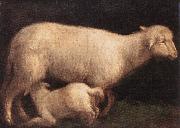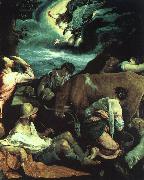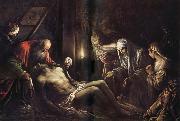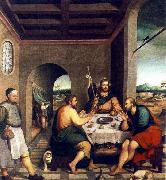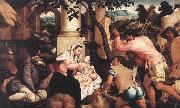
|
Artists
Index
|
||
|
BASSANO, Jacopo
|
||
|
Sheep and Lamb dghj BASSANO, Jacopo11.jpg Painting ID:: 4969 |
c. 1560 Oil on canvas Galleria Borghese, Rome | |
| |
|
|
|
|
||
|
The Annunciation to the Shepherds new3/BASSANO, Jacopo_XQnWwd.jpg Painting ID:: 18864 |
1533, oil on canvas, Belvoir Castle at Leicestershire, England | |
| |
|
|
|
|
||
|
Le Christ descendu de la Croix new4/BASSANO, Jacopo-257746.jpg Painting ID:: 30991 |
mk70 Toile H.1.54 L.2.25 Paris,musee du Louvre | |
| |
|
|
|
|
||
|
Supper at Emmaus new21/BASSANO, Jacopo-925939.jpg Painting ID:: 63018 |
1538 Oil on canvas, 235 x 250 cm Sacristy, Parish Church, Cittadella Although undated, the painting is likely to go back to about 1538, a particularly felicitous period in Jacopo Bassano's art. Lorenzetti (1911) places it in the early part of the artist's stay in Bonifacio da Pitati's workshop and pointed out the obvious links with the latter's painting on the same theme, now to be seen in the Brera. There is a certain contrast between the solemn, hieratic figure of Christ and the rough and realistic close-up of the innkeeper on the one hand, and on the other, the little scene of the crouching dog being teased by the cat from a distance. The postures of the two disciples, the laboured perspective of the table, and some genre episodes were to recur in his later "Supper" version, now in the Borghese Gallery, Rome. The still-life in the centre of the work standing but against the linen tablecloth is a marvel of pictorial observation. A virtually lone harbinger of the main marks and elements of forthcoming Venetian painting (Tintoretto), Jacopo Bassano here sweeps the scene clear. In any case, light is the master here; it picks out the details and throws them into sharp outline. Artist: BASSANO, Jacopo Painting Title: Supper at Emmaus , 1551-1600 Painting Style: Italian , , religious | |
| |
|
|
|
|
||
|
Adam and Eve in the Garden of Eden new21/BASSANO, Jacopo-554326.jpg Painting ID:: 63073 |
1544-45 Oil on canvas, 139,5 x 219 cm Royal Collection, Windsor The Adoration of the Shepherds is an imposing composition dating from around 1544-45 and the time of the artists early maturity. It was during this decade that Bassano painted a number of successful works on a large scale, which helped to establish him as a major artist of the Venetian school. The main compositional features of this painting are the treatment of the architecture, the Virgin's expression of concern for the Child, and the figure of the shepherd who acknowledges the Holy Family by removing his headgear. These features appear to be derived from a painting of the same subject by Titian, the original of which was painted for the Duke of Urbino in 1532-34 and may be the ruined panel in the Palazzo Pitti, Florence. Bassano clearly knew of Titian's painting, but almost certainly through the woodcut by the Master I.B. (Giovanni Boitto), which he seems to have made use of in the 1530s. The composition follows the same direction as the print, which reverses Titian's painting. It is notable that Bassano often redeployed figures in his paintings so that the figure of Joseph in the present work is found in reverse in the Rest on the Flight into Egypt and the kneeling shepherd in the foreground is used in reverse in the Adoration of the Magi. Apparently, from quite an early date, the artist kept a stock of drawings in his studio for this purpose. Apart from Titian, other influences have been cited in the context of Bassano's composition. The architectural features and the shepherd playing the bagpipes recall the woodcut of the Nativity in D?rer's Little Passion of 1511. On a general basis the naturalistic aspects of the composition are often compared with Netherlandish painting, particularly the work of artists such as Pieter Aertsen. Such observations perhaps over-emphasise the eclectic elements in Bassano's art when it is preferable to stress the scale of the work, the firm drawing, the warm colouring and the view of the artist's home town of Bassano del Grappa, seen in the background against the mountains. Iconographically, the broken elements of the classical architecture denote the passing of the Old Law in favour of the New Law symbolised by the Christ Child. Similarly, the tree prefigures the death of Christ on the cross. Artist: BASSANO, Jacopo Painting Title: Adoration of the Shepherds , 1551-1600 Painting Style: Italian , , religious | |
| |
|
|
|
|
||
| Prev artist Next artist | ||
|
Also Buy::. For Following Paintings / Artists / Products, Please Use Our Search Online: |





